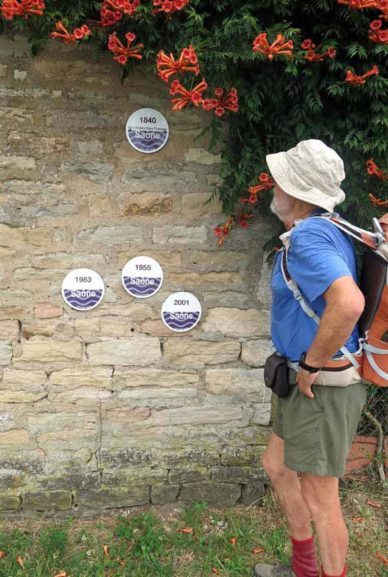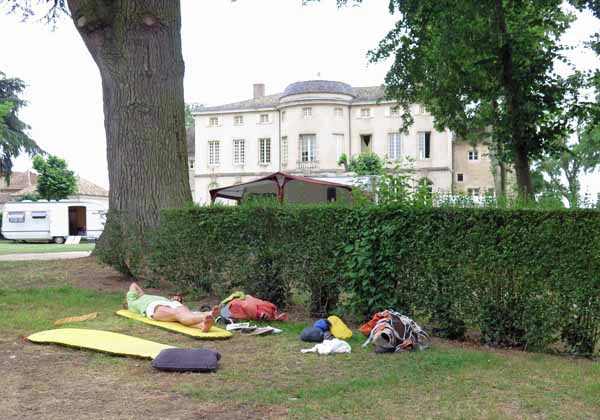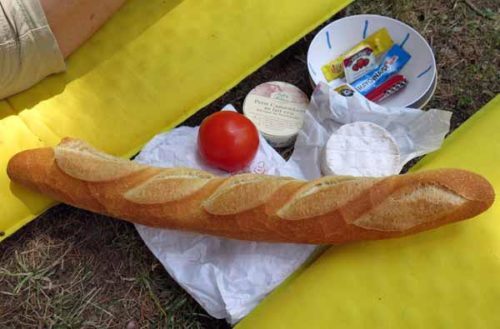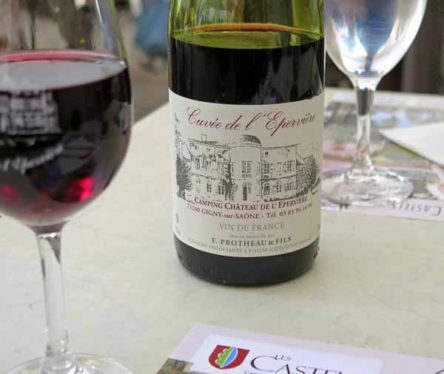Saturday, 24 June 2017
Distance 11 km
Duration 2 hours 20 minutes
Ascent 1 m, descent 1 m
Map 142 of the
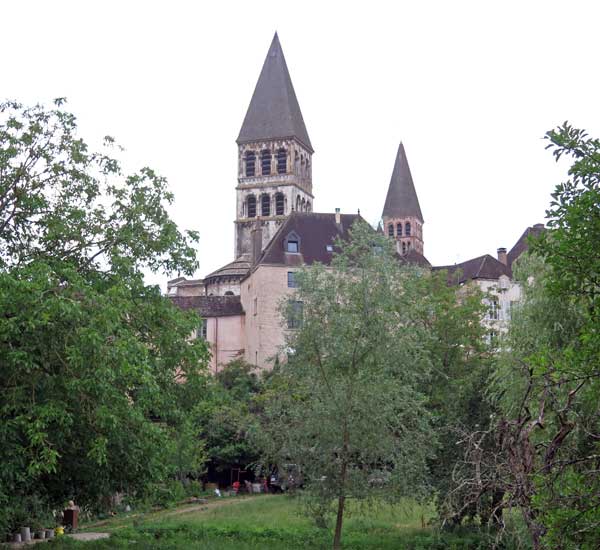
Because of my blisters and general feebleness the day before, we had stopped at Tournus instead of continuing to our original destination, the Château de l’Epervière.
This meant that today we only had eleven kilometres to walk, so obviously the thing to do was to go back to the town and have a prolonged breakfast before setting off.
It was well before 7 when we left the slumbering campsite via the back gate and retraced our steps past the lower wall of the abbey.
This grand fortified Romanesque building houses the remains of Philibert, a seventh-century saint, whose bones had been venerated on the island of Noirmoutier, off the coast near Nantes, until Viking attacks had forced the monks to flee.
They arrived (with the bones) at Tournus in the ninth century, and the present building was begun around the year 1000, although most of it is much younger.
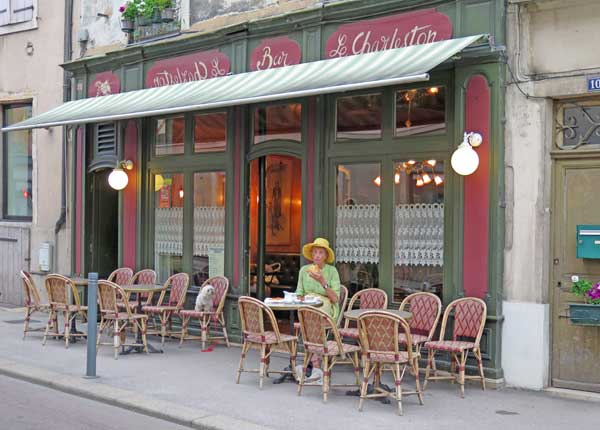
At the first bridge in the town, we were pleased to see a boulangerie a few steps along the street, and a bar a few steps beyond that, with its lights on and the door open.
We were the first customers of the day, apart from the owner’s small white dog who was already occupying the chair next to us.
The pastries (two croissants, a chausson and a pain aux raisins) were rather stodgy but went down well with our double round of coffee.
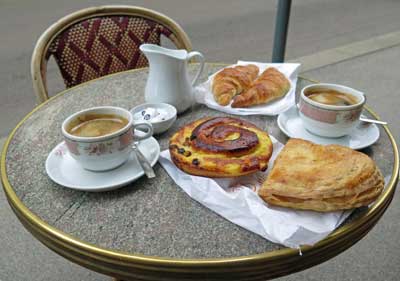
The return walk to the château was entirely along the riverbank, sometimes on a small road and sometimes on a dusty wheel track.
There was no shade, but it was early enough in the day for the sun to be welcome.
A gigantic white cruise vessel, low in the water and vaguely menacing, like a crocodile, surged past us and vanished around a bend. It seemed deserted, but we guessed that all the passengers were down below having breakfast.


An hour later we almost caught up to it – there had evidently been a long delay getting through the lock at Ormes.
The riverbank was not as empty as it looked on the map. There were lone fishermen from time to time, all set up beside their cars with their rods, buckets, folding chairs, radios and thermoses.
These were mostly only capable of a polite grunt as we walked past, but then we came on a group of chattering students who had slept on the riverbank and were now having breakfast (it was
Half an hour later we arrived at the first houses that we had seen since leaving Tournus – the straggling village of la Colonne, as close to the river as it was possible to be.
On a wall there were discs showing how high the water had risen in various floods (French rivers are not as wild now as they used to be, before they were tamed by barrages).
At this village we left the river path and took a small road that soon reached the camping ground that we were seeking.
Through a tall hedge we saw vans and tents, lakes, lawns, paths, people strolling, everything except the entrance. We eventually found it half a kilometre further on, at the far end and around the corner.
Not only was this a very large camping ground, but it was also a highly superior one. It occupied the grounds of a small, elegant sixteenth-century château which had fallen into decrepitude before being restored in recent decades.
Inside the gates, the gravel forecourt was adorned with tubs of flowers and some stone buildings, newish but in harmony with the château itself. One was the reception, and the rest were a bar, a shop and the ablution blocks.
At the reception desk, people were checking out rather than arriving (except for us), as it was only
The guests were either English or Dutch, with a few Germans, but no French, and everyone was speaking English. We felt that we had entered some luxurious Anglophone space station that had landed in the French countryside, unnoticed by the local population.
The lively Dutchman on the desk suggested that we make a booking if we wanted to dine at the restaurant, so we did. He then allocated us an exceptionally good tent site, on a little lake just past the château, with a massive 500-year-old cedar tree providing shade.
After showers we went to the little shop and got a baguette, a tomato and a raw-milk camembert, all of which were poignantly delicious. Having lunch at all was becoming a novelty to us.
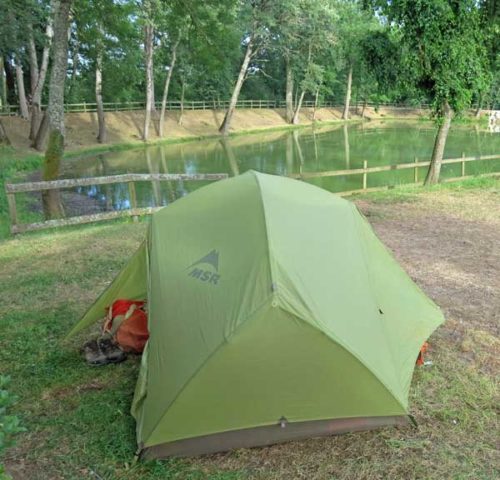
Our afternoon slumber was slightly disturbed by having to shift our mattresses into the ever-moving shade of the mighty cedar, but by
We had coffee and watched a bit of Wimbledon on the big screen. The bar and forecourt were crowded with visitors using their mobile phones, as there was WiFi here.

Dinner was served at
Before we sat down our names were checked on a list. Some people were also eating indoors, but we were glad to be outside.
Naturally there were no humble carafes of wine at this establishment, so we had a bottle of their own label, Cuvée de l’Epervière.

We began our meal by sharing a salade de chèvre chaud (hot goat’s cheese on toast, plus salad), always Keith’s favourite.

For the main course, Keith had the best boeuf Bourgignon that he had ever tasted, and that was saying a lot, as he has it whenever possible. I tried it too and it was a dark, rich, harmonious work of art.
I had poulet à la crème, as I am very fond of cream, and also because it came with gratin dauphinois, which I love particularly.

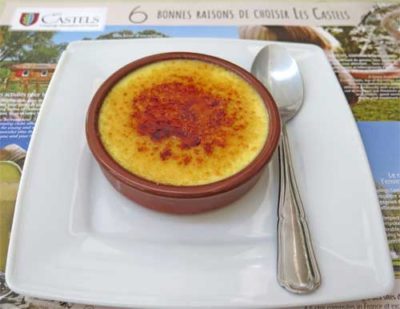
The final course took the form of crème brûlée for Keith – he had no choice in this, as it was fieldwork for his upcoming Ph.D thesis entitled “Regional Variations in French Crèmes Brûlées”.
I ordered cheese, but put it away for the morrow, as is my habit. We had not finished the bottle of wine, but the remaining bit vanished discreetly into my half-litre water bottle which I had brought for the purpose.

By the time we rose from this elegant and satisfying meal, the market umbrellas had been lowered and the last mellow light of the evening was gilding the walls of the château.
Previous section: Simandre-sur-Suran to Tournus
